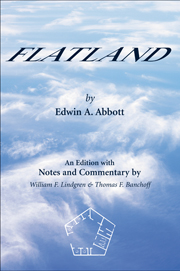Book contents
- Frontmatter
- Contents
- Acknowledgments
- Introduction
- Flatland with Notes and Commentary
- Part I This World
- Part II Other Worlds
- Epilogue by the Editor
- Continued Notes
- Appendix A Critical Reaction to Flatland
- Appendix B The Life and Work of Edwin Abbott Abbott
- Recommended Reading
- References
- Index of Defined Words
- Index
Appendix B - The Life and Work of Edwin Abbott Abbott
Published online by Cambridge University Press: 05 August 2013
- Frontmatter
- Contents
- Acknowledgments
- Introduction
- Flatland with Notes and Commentary
- Part I This World
- Part II Other Worlds
- Epilogue by the Editor
- Continued Notes
- Appendix A Critical Reaction to Flatland
- Appendix B The Life and Work of Edwin Abbott Abbott
- Recommended Reading
- References
- Index of Defined Words
- Index
Summary
Abbott chronology
There is no full-scale biography of the author of Flatland, Edwin Abbott Abbott. The entry for Abbott in the Dictionary of National Biography, written by his student Lewis Farnell and revised by Rosemary Jann, supplies a valuable outline of his life. A. E. Douglas-Smith, who had access to Abbott's weekly letters to Howard Candler as well the autobiographical, “Confessions of a rationalist Christian” (both now lost), gives a good account of Abbott as headmaster in Douglas-Smith (1965). Former students have given compelling testimony to his greatness as a teacher (see Conway (1926); Farnell (1926); Steggall (1926)). Abbott expounds his liberal theology in several popular works, for example, Philochristus, The Kernel and the Husk, and Through Nature to Christ. William Sanday provides an overview of Abbott's prodigious biblical scholarship in his reviews of Abbott's books in The Times Literary Supplement. A biographical sketch of even modest length is beyond our scope; instead we offer this chronology, which provides a framework of Abbott's life and work.
1838. Edwin Abbott Abbott is born in London on December 20. He was the fifth child and oldest son of Edwin Abbott (1808–1882) and Jane Abbott Abbott (1806–1882), who were first cousins. His father was “a most efficient and popular” headmaster of the Philological School, Marylebone, for forty-five years. He was one of the first to advocate a more thorough English training in the schools.
- Type
- Chapter
- Information
- FlatlandAn Edition with Notes and Commentary, pp. 239 - 266Publisher: Cambridge University PressPrint publication year: 2009



